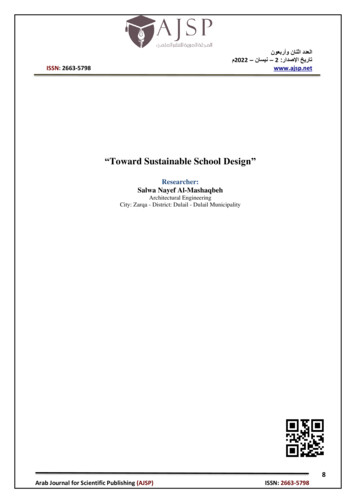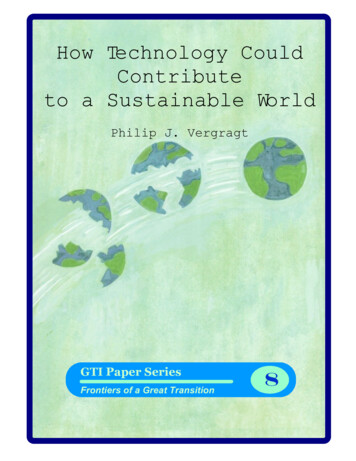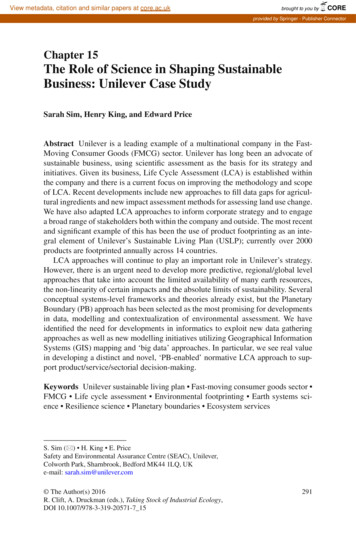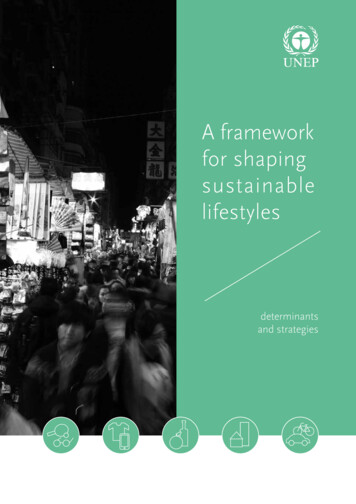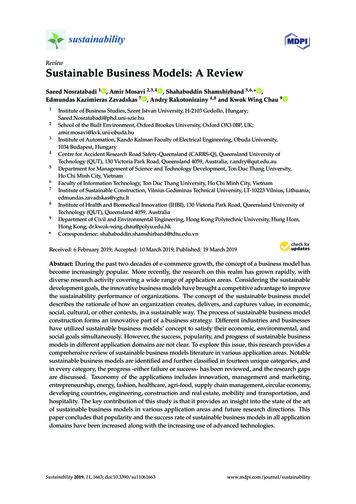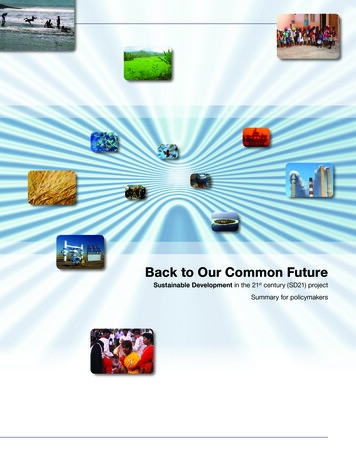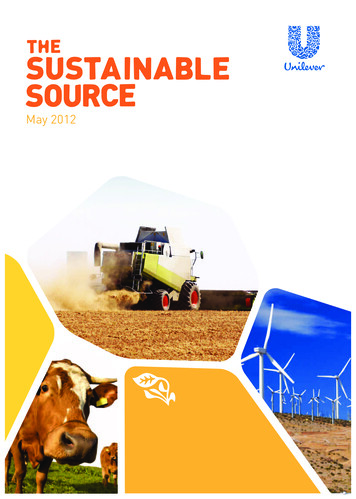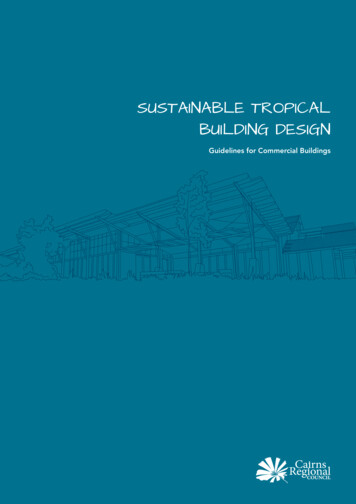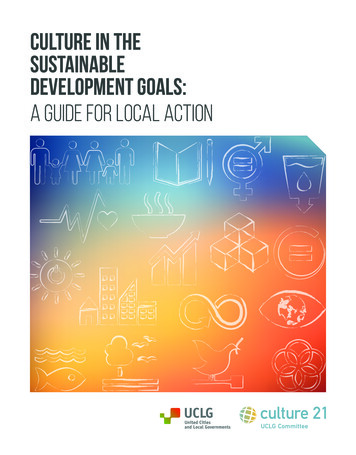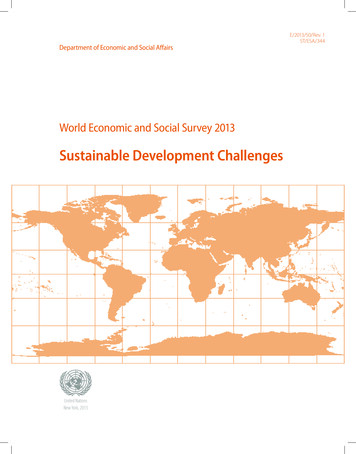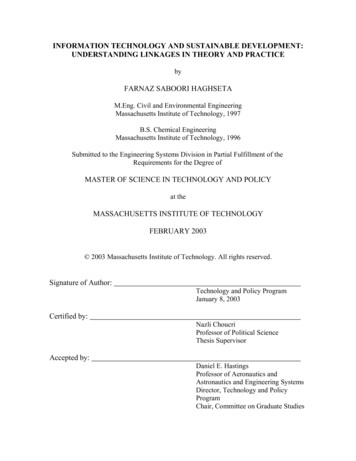
Transcription
INFORMATION TECHNOLOGY AND SUSTAINABLE DEVELOPMENT:UNDERSTANDING LINKAGES IN THEORY AND PRACTICEbyFARNAZ SABOORI HAGHSETAM.Eng. Civil and Environmental EngineeringMassachusetts Institute of Technology, 1997B.S. Chemical EngineeringMassachusetts Institute of Technology, 1996Submitted to the Engineering Systems Division in Partial Fulfillment of theRequirements for the Degree ofMASTER OF SCIENCE IN TECHNOLOGY AND POLICYat theMASSACHUSETTS INSTITUTE OF TECHNOLOGYFEBRUARY 2003 2003 Massachusetts Institute of Technology. All rights reserved.Signature of Author:Technology and Policy ProgramJanuary 8, 2003Certified by:Nazli ChoucriProfessor of Political ScienceThesis SupervisorAccepted by:Daniel E. HastingsProfessor of Aeronautics andAstronautics and Engineering SystemsDirector, Technology and PolicyProgramChair, Committee on Graduate Studies
Page 2
Information Technology and Sustainable Development:Understanding Linkages in Theory and PracticebyFarnaz Saboori HaghsetaSubmitted to the Engineering Systems Division on January 8, 2003in Partial Fulfillment of the Requirements for the Degree ofMaster of Science in Technology and PolicyABSTRACTSustainable development is one of the most significant societal challenges of the 21st century.One global trend with significant implications for sustainable development is the extraordinarilyrapid development and application of information technology (IT), often referred to as the “ITrevolution.”As a result of the “IT revolution,” there have been many efforts to leverage IT for sustainabledevelopment, particularly in the context of empowering developing countries. The first mainfinding of this thesis is that IT can be leveraged effectively to facilitate transitions tosustainability so long as potential negative linkages are identified and addressed adequately. Tohelp understand this dynamic, this thesis develops a conceptual framework of the positive andnegative linkages between IT and sustainability.A case study, the Global System for Sustainable Development (GSSD), is presented to put theconceptual linkages into context. GSSD is a global knowledge network devoted to sustainabilityissues. The experiences accumulated over the last two years from the development andmanagement of GSSD help to illustrate significant institutional, organizational, and technicalbarriers to leveraging IT for sustainability. One major contribution of this thesis is theformulation and implementation of an innovative global workflow process to address theseissues.The GSSD case study leads to another major finding of this thesis, which is that IT caneffectively facilitate transitions to sustainability as long as the technology is customized toaddress critical institutional and organizational barriers. This finding is especially important inthe context of cultural diversity and an increasingly globalized world.The main contribution of this thesis is a new strategic methodology for assessing the impact ofIT advances on prospects for sustainable development. The approach consists of two mainelements: (1) analysis of the linkages between the IT tool and sustainability goals and (2)identification of critical institutional and organizational contexts and barriers, and customizationof the IT tool to address these issues. Strategic consideration of these elements will help tounleash the enormous potential of IT for sustainable development.Thesis Supervisor: Nazli ChoucriTitle: Professor of Political SciencePage 3
Page 4
ACKNOWLEDGEMENTSI would like to extend my sincere gratitude and appreciation to the faculty, family, and friendswho made this thesis possible. First, I am grateful to my thesis supervisor, Nazli Choucri, forproviding me with steadfast guidance, support, and encouragement over the last two years. Iwould also like to thank Stuart Madnick and Dave Marks for their valuable insights and advice. Iwould further like to acknowledge the financial supporters of my research, which include theGlobal System for Sustainable Development (GSSD), the Laboratory for Energy and theEnvironment (LFEE), the Alliance for Global Sustainability (AGS), the Martin Foundation, theSloan School of Management, and the Department of Political Science. I also extend mygratitude to IBM Lotus Corporation for providing the technology, support, and collaboration thathelped make the GSSD project possible.I would also like to thank my friends in the Technology and Policy Program, with whom I haveshared this tremendous learning experience over the last two years. It has been a pleasureworking with all of you, and I hope our paths cross again in the future.Finally, this journey would not have been possible without my family. To my best friend andsoon-to-be husband, Faraz, I thank you for your constant love and support. These last two yearswould have been unbearable without you by my side. To my mother, I owe you an eternal debtof gratitude for sacrificing so much while raising me. Your unfailing love, encouragement, andmotivation have given me the opportunity to be where I am today.Page 5
Page 6
TABLE OF CONTENTS1. Introduction. 111.1 Current Trends and Context. 111.2 Significant Challenges . 141.3 Thesis Objectives . 151.4 Thesis Outline . 152. IT and Sustainable Development: A Literature Review . 162.1 Introduction. 162.2 Major Studies on IT and Development. 162.2.1 Overview. 162.2.2 Reports by the United States, European Union, and OECD. 172.2.3 Reports by International Institutions. 202.3 Summary . 233. IT and Sustainable Development: Negative Linkages. 253.1 Introduction. 253.2 Over-Reliance on IT for Addressing Conceptual Ambiguity . 253.3 Decrease in Information Quality. 253.4 Environmental Rebound Effects . 263.4.1 Primary Effects . 263.4.2 Secondary Effects . 273.5 Economic Dependence. 283.6 “Digital” and “Knowledge” Divides. 313.6.1 Introduction. 313.6.2 Physical Barriers . 323.6.3 Knowledge Barriers . 333.6.3.1 Lack of Multilingual Support. 333.6.3.2 Dearth of Local Knowledge. 333.6.3.3 Limited Search Capabilities. 333.7 Summary . 334. IT and Sustainable Development: Positive Linkages . 354.1 Introduction. 354.2 Waste Minimization. 354.3 Energy Savings . 364.4 Economic Stimulation. 394.5 Lifestyle Changes. 414.6 Social Benefits . 424.7 Information Integration. 434.8 Knowledge Networks: GSSD Case Study . 445. IT and Sustainable Development in Context: Global System for Sustainable Development. 455.1 Overview of the Global System for Sustainable Development (GSSD) . 455.1.1 Conceptual Framework. 45Page 7
5.1.2 Physical Structure . 495.1.3 GSSD Partnerships and Knowledge Networking . 505.2 Key Features and Contributions of GSSD: Addressing Six Major Barriers to Using IT forSustainability. 535.2.1 Conceptual Framework to Address Theoretical Ambiguity . 535.2.2 Robust Search Capabilities to Accommodate Diverse Information Needs . 535.2.3 Support for Local Knowledge Provision . 545.2.4 Multilingual Operations . 555.2.5 Transcending Physical Barriers . 565.2.6 Quality Control to Prevent “Information Overload” . 565.3 GSSD Administration: Organizational, Institutional, and Technological Barriers . 575.3.1 Organizational Issues and Institutional Imperatives . 575.3.1.1 IBM Lotus Technology and Organizational Change . 615.3.2 Technological Issues. 615.4 Responses to Critical Technological, Organizational, and Institutional Challenges: AnInnovative Global Workflow Application . 625.4.1 Evolution from Knowledge Network to Global Workflow Application . 625.4.2 Development of a Global Workflow Application. 635.4.3 Workflow and the GSSD Knowledge Base . 755.4.4 Other Potential Applications of Global Workflow . 766. Lessons Learned: Strategies for Developing Innovative IT Applications for SustainableDevelopment . 776.1 GSSD Case Study: A Summary. 776.1.1 GSSD Linkages. 776.1.2 Global Workflow Application . 786.2 Priorities for Advances in Global Knowledge Networks for Sustainable Development. 787. Conclusion . 807.1 Main Findings . 807.1.1 Strategic Approach to Assessing IT Tools for Sustainability. 807.1.1.1 Linkages. 807.1.1.2 Institutional, Organizational, and Technological Barriers. 807.2 Further Research Needs . 80LIST OF FIGURESFigure 1.1 Knowledge Intensity of Today’s Economies . 13Figure 1.2 IT Contribution to Gross Domestic Product, 2001 . 14Figure 2.1 Percent of U.S. Households with a Computer By Race/Hispanic Origin . 17Figure 2.2 Internet Hosts in OECD Countries, 2001 . 20Figure 2.3 World Bank's Logic for Supporting IT Projects in the Developing World .21Figure 2.4 Development Dynamic Framework . 23Figure 3.1 Stock History for Amazon.com . 29Page 8
Figure 3.2 GDP Decline after “Bubble Burst” . 29Figure 3.3 Impact of the “Bubble Burst” on World Export Growth . 30Figure 3.4 Income Distribution of Telephone, Mobile, and Internet Users . 31Figure 4.1 Dematerialization by Moore’s Law . 36Figure 4.2 Energy Intensity Trends in the U.S. . 37Figure 4.3 Relationship between Internet Use and Economic Growth .40Figure 4.4 Software Exports in India, 1995-2001 . 41Figure 4.5 Tarahaat.com: A Portal Providing Social Services to Indian Rural Villages . 43Figure 5.1. GSSD Conceptual Framework: Slices . 46Figure 5.2. GSSD Conceptual Framework: Rings . 47Figure 5.3. Levels of Granularity in the GSSD Structure . 48Figure 5.4. Levels of Granularity in GSSD: Agriculture Example . 49Figure 5.5. Physical Structure of GSSD . 50Figure 5.6. Critical Role of GSSD Partners . 51Figure 5.7. Overall Structure of the GSSD Knowledge Network . 52Figure 5.8. GSSD Search Capabilities . 54Figure 5.9. Screen Shot of the GSSD Glossary . 55Figure 5.10 Recent Timeline for the GSSD Project . 59Figure 5.11 Importance of Workflow to the GSSD System . 63Figure 5.12 GSSD Global Workflow Process .65Figure 5.13 High Level View of GSSD Workflow . 74Figure 5.14 The Role of Workflow in GSSD Knowledge Base Dynamics . 75LIST OF TABLESTable 1.1 Varying Definitions and Perspectives of Sustainable Development .11Page 9
Page 10
1. Introduction1.1 Current Trends and ContextSustainable development, also referred to as sustainability, is one of the most significant societalchallenges of the 21st century. The Brundtland Commission, in its widely accepted andreferenced statement, defines sustainable development as meeting “the needs of the presentwithout compromising the ability of future generations to meet their own needs1.” Beyond thisdefinition, there is not much consensus about the specific operational meaning of sustainabledevelopment. As illustrated in Table 1.1, the diversity and, at times, divergence among variousapproaches to sustainability issues, stems from the wide array of definitions for “sustainabledevelopment.”What is to be sustained?Nature Earth Biodiversity EcosystemsLife Support Ecosystem Services Resources EnvironmentCommunity Cultures Groups PlacesFor how long? 25 years “Now and in thefuture” Forever Linked by:OnlyMostlyButAndOrWhat is to be developed?People Child Survival Life Expectancy Education Equity Equal OpportunityEconomy Wealth Productive Sectors ConsumptionSociety Institutions Social Capital States RegionsTable 1.1 Varying Definitions and Perspectives of Sustainable DevelopmentSource: National Research Council (1999)The issue of conceptual ambiguity is still prevalent, as illustrated by the vast diversity inapproaches utilized by various institutions, as revealed by the literature review in Section 2 and1World Commission on Environment and Development (1987).Page 11
highlighted in Section 3.2. The premise of this thesis is that the aim of sustainability is to attain astate of maintained economic and social development that does not dwindle or destroy thenatural resources used for current and future prosperity. This broad definition attains furtherrefinement in scope and focus in Sections 3 and 4 of this thesis, and even furtheroperationalization in Section 5.1, when a conceptual framework for sustainability is discussed2.A global trend with significant implications for sustainable development is the extraordinarilyrapid development and application of information technology (IT)3, often referred to as the “ITrevolution.” By drastically reducing the cost of information and communication, IT advanceshave had tremendous economic effects. By helping to drive the globalization of markets andcontributing to a greater knowledge intensity of economies, IT has led to the “knowledge-basedeconomy4,” also known as the “new economy5” or “weightless economy6.” Figure 1.1 illustrateshow IT has helped to drive knowledge-intensity growth in economic development.2The conceptual framework is explained in detail in Choucri (2000).This paper uses the term “IT” to refer to hardware, software, telecommunications, and Internet technologies.4OECD (1996).5OECD (2000).6Economist (2000).3Page 12
Figure 1.1 Knowledge Intensity of Today’s EconomiesSource: OECD (1999)Despite the economic downturn that began in 2000 and continues today, IT continues to play asignificant role in economic prosperity. Figure 1.2 illustrates how IT is contributing a significantshare to the productivity growth of many countries.Page 13
Figure 1.2 IT Contribution to Gross Domestic Product, 2001Source: OECD (2002)1.2 Significant ChallengesSustainable development represents a significant global challenge by forcing society to balancethe desire to prosper economically with the responsibility to ensure continued socialdevelopment and environmental protection. Developing countries are particularly vulnerable andface tremendous obstacles to sustainability. As a result, many efforts have been focused on IT asa potentially powerful, yet accessible and affordable, means to facilitate the transition towardssustainability. For example, there are a significant number of international initiatives focused onthe potential role of IT in the empowerment of developing countries.7However, the linkages between IT and development, positive as well as negative, need to bebetter understood to determine which issues can be effectively addressed using IT, how IT toolscan be used, and in what context should the technology be implemented. Deepening “digital” and“knowledge” divides, over-reliance on IT as a panacea to all problems, and environmentalrebound effects are among the factors that affect a country’s ability to implement effective ITstrategies for sustainable development. Therefore, this consideration of linkages is a critical gapin the current research on IT and sustainable development and frames a key focus of this thesis.7For example, see projects implemented by UNDP’s Info21 (http://www.undp.org/info21/ ), World Bank’s InfoDev(http://www.infodev.org/ ), and UN’s ICT Task Force (http://www.unicttaskforce.org/ ).Page 14
1.3 Thesis ObjectivesThis thesis intends to focus on the challenges related to leveraging applications of IT forsustainable development. In some cases, IT advances will likely help to alleviate obstacles tosustainable development, while in other cases, IT may have a counter-productive effect. Thisstudy seeks to highlight both positive and negative attributes of IT, in order to gain a morecomprehensive understanding of how IT affects sustainability.The focus of this thesis is on a case study of an IT application for sustainable development,known as the Global System for Sustainable Development (GSSD). The GSSD case study helpsto illustrate how IT has the potential to play an enabling role for sustainability, as long aspotential limitations and rebound effects are identified and addressed adequately.The GSSD case study also illustrates the importance of non-technical factors to IT feasibilityassessments, such as organizational and institutional constraints, and ways in which they haveimpacts on the applications of the technology. This study seeks to demonstrate how such factorscan hinder the effectiveness of IT implementation and, conversely, spur the invention of a new ITtool to address these issues. In this context, the thesis shows how an innovative global workflowtool was developed and implemented for the GSSD project.Overall, this thesis contributes to current research on IT and sustainability specifically bypresenting a new methodology for strategically assessing potential impacts of IT on reachingsustainability-supporting objectives. The methodology consists of a theoretical component whichidentifies key linkages of IT and sustainability. The empirical contributions to the methodologyare a result of the GSSD case study, which raised the importance of institutional andorganizational barriers to IT implementation and the design of IT strategies to address thesebarriers.1.4 Thesis OutlineThis thesis begins with a literature review on studies to date which have examined the impact ofIT on development. First, common weaknesses in these studies are identified. Second, thesefindings are then incorporated into a conceptual framework that articulates the positive andnegative linkages between IT and sustainability, with examples that illustrate the linkages. Third,the GSSD case study is examined in detail to assess the implications of IT for addressingsustainability challenges. The technical evolution of GSSD into a more sophisticated applicationis examined in considerable detail. This effort results in some specific conclusions regarding theflexibility and robustness of IT advances for addressing increasingly complex, global issues,such as those related to sustainable development. Finally, the study concludes by integrating themain findings of this research into a new methodology for addressing the linkages between ITand sustainability.Page 15
2. IT and Sustainable Development: A Literature Review2.1 IntroductionUntil a few years ago, the majority of the literature on the impacts of IT on development wasfocused on industrialized countries. For example, the Organization for Economic Cooperationand Development (OECD) web site alone has approximately 600 different reports, case studies,and other documents, mostly focused on IT efforts in the advanced OECD countries8. In contrast,the World Bank, which has conducted one of the most substantial efforts on the sustainabledevelopment of developing countries, has approximately 25 reports examining various aspects ofIT and development in the developing world9.Overall, the majority of studies on both developing and developed countries exhibit similarshortcomings: The majority of efforts have focused on physical infrastructure and connectivity,resulting in insufficient attention to users, content, and the relevance of nontechnical factors to leveraging IT for sustainability; Analyses are relatively theory-free; Studies are generally non-empirical and prescriptive in nature; and Research has been overwhelmingly singular in focus, with very little effort todevelop integrated or holistic approaches to understanding issues in IT anddevelopment.The following sections provide more detail on the nature of the major studies, their performanceto date, and their implications. On this basis, we illustrate how critical gaps in this literature areposing significant barriers to a comprehensive understanding of the linkages between IT andsustainability.2.2 Major Studies on IT and Development2.2.1 OverviewFor the perspective on industrialized countries, major reports have been produced by the UnitedStates, the European Union countries, and OECD. Reports on IT impacts on the developing8See OECD’s Information and Communication Technologies web site mentation-13-nodirectorate-no-no-no-13,00.html .9See World Bank’s Global Information and Communication Technologies web site InfoResources?OpenView .Page 16
world have been completed mainly by international and inter-governmental institutions, such asthe World Bank and the United Nations (U.N.).2.2.2 Reports by the United States, European Union, and OECDThe United States government has produced a large number of reports related to the impacts ofIT on the country’s development. For example, the United States Department of Commerceprovides an annual report on the “digital economy10” and regular reports on the “digital divide11”in the U.S. While these reports provide plenty of economic and social data related to IT and the“new economy,” there is no discussion of the broader implications of these findings onsustainable development in the U.S., not even in the most recent versions of these reports.Moreover, although certain potential negative linkages are identified, such as “digital divide”effects, there is no mention of other potentially significant negative impacts, such asenvironmental rebound effects due to the intensified use of IT products and services.Figure 2.1 below illustrates a recurring feature of digital divide reports: reliance on physicalindicators for assessing the extent of the digital divide. In other words, these reports consistentlydefine one of the most significant negative linkages, the “digital divide,” in purely physicalterms.Figure 2.1 Percent of U.S. Households with a Computer By Race/Hispanic OriginSource: United States Department of Commerce (2000b)1011United States Department of Commerce (2002), (2000a), (1999a), (1998a).United States Department of Commerce (2000b), (1999b), (1998b), (1995).Page 17
Figure 2.1 shows that progress has been made with all racial segments of the U.S. population interms of computer ownership. However, the figure does not provide any information on theextent to which the minority groups have been given access to more knowledge as a result. Thereduction of non-technical barriers, such as the ability to access content and build capacity, areequally important considerations as connectivity. Nevertheless, these issues are not addressed inthese reports, and as a result, relevant indicators are not presented.In addition to the U.S., the European Union (E.U.) has been very active at developing policiesrelevant to the emerging “information society,” which is the term used by the E.U. to refer to thenew societal and economic conditions brought about by the IT revolution. The EuropeanCommission has developed an Information Society website, whose aim is to: increase “publicawareness and understanding of the potential impact of the Information Society and its newapplications throughout Europe,” optimize “the socio-economic benefits of the InformationSociety in Europe,” a
Jan 08, 2003 · Massachusetts Institute of Technology, 1997 B.S. Chemical Engineering Massachusetts Institute of Technology, 1996 . as revealed by the literature review in Section 2 and 1 World Commission on Environment and Development (1987). Page 12 highlighted in Section 3.2. The premise of thi
